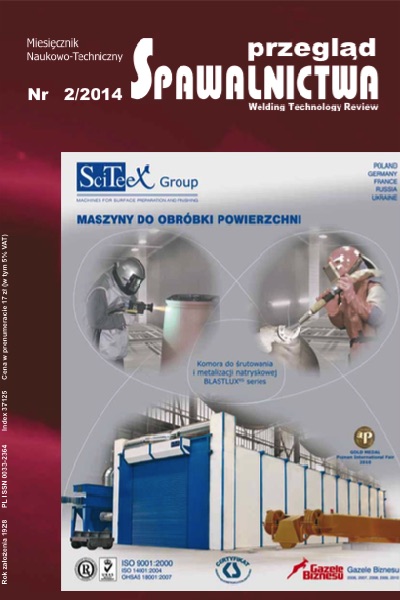Przyczepność powłok miedzi na podłożu aluminiowym naniesionych metodą LPCS
##plugins.themes.bootstrap3.article.main##
Abstrakt
Metoda niskociśnieniowego natryskiwania na zimno (ang. Low Pressure Cold Spraying LPCS) umożliwia nanoszenie powłok z miękkich metali, takich jak Sn, Zn, Al, Cu, ewentualnie ni i Fe, oraz ich stopów. W procesie zaleca się stosowanie domieszki ceramiki do proszku metalu, w celu polepszenia właściwości mechanicznych uzyskanych warstw oraz zwiększenia wydajności procesu. Budowanie warstw z samego proszku metalu jest również możliwe. W pracy badano wpływ zastosowanego proszku na właściwości mechaniczne oraz mikrostrukturę uzyskanych powłok, naniesionych przy stałych parametrach procesu. Skupiono się na wykonaniu powłok miedzianych, które są powszechnie stosowane w elektrotechnice. Wykorzystano komercyjne proszki dendrytyczne; proszek Cu z domieszką Al2O3 (w pro- porcji obj. 50% Cu/50% Al2O3) o granulacji -45+15 μm oraz proszek Cu o granulacji -50+15 μm, którymi pokryto stop aluminium AA1350. Przeprowadzone analizy miały na celu określenie przyczepności warstw oraz ich mikrotwardości. Powłoki były odrywane zgodnie z normą PN-EN 582, bez obróbki powierzchni. Warstwy natryskiwano przy wykorzystaniu manipulatora, co umożliwiło uzyskanie równomiernie nałożonej powłoki.
Bond strength of copper coatings deposited on aluminum alloy with LPCS method
Abstract
Low Pressure Cold Spraying method (LPCS) allows build coatings with soft metals such as Sn, Zn, Al, Cu, even ni and Fe and their alloys. In the process admixture of ceramics to the metal powder is recommended to improve mechanical properties of deposited coatings and increase deposition efficiency. Building coatings with pure powder without ceramic is also possible. In the manuscript the influence of used powder on mechanical properties and microstructure of obtained coatings, deposited with constant process parameters is presented. Copper coatings were deposited, which are commonly used in the electrical engineering. Two kinds of commercial available dendritic powders, Cu powder with Al2O3 admixture (50% Cu/50% vol. Al2O3) with a particle size of -45+15 μm and pure Cu powder with a particle size of -50+15 μm were used in the tests. Aluminum alloy AA 1350 was used as a substrate. The aim of the research was to identify coatings bond strength and microhardness. The bond strehgth tests consisted in pulling off the coatings in accordance with standard Pn-En 582 without coating surface machining preparation. In the spraying process manipulator was used, what gives uniformly deposited coatings.
Pobrania
##plugins.themes.bootstrap3.article.details##
Creative Commons CC BY 4.0 https://creativecommons.org/licenses/by/4.0/
Artykuły czasopisma Welding Technology Review (Przegląd Spawalnictwa) publikowane są w otwartym dostępie na licencji CC BY (licencja Creative Commons Uznanie autorstwa 4.0 Międzynarodowe). Licencja CC BY jest najbardziej otwartą dostępną licencją i uważaną za „złoty standard” w formule otwartego dostępu; jest również preferowany przez wielu fundatorów badań. Licencja ta umożliwia czytelnikom kopiowanie i redystrybucję materiału na dowolnym nośniku i w dowolnym formacie, a także zmienianie, przekształcanie lub budowanie na nim materiału, w tym do użytku komercyjnego, pod warunkiem wskazania oryginalnego autora.
Bibliografia
T. Schmidt, F. Gärtner, H. Assadi, H. Kreye, Development of a Generalized Parameter Window for Cold Spray Deposition, Acta Mater. 54, 2006, s. 729÷742.
Xian-Jin ning, Jae-Hoon Jang, Hyung-Jun Kim, The effects of powder properties on in-flight particle velocity and deposi- tion process during low pressure cold spray process, Applied Surface Science, 2007, vol. 253, s. 7449÷7455.
H. Koivuluoto, J. Lagerbom, M. Kylmalahti, P. Vuoristo, Microstructure and Mechanical Properties of Low-Pressure Cold-Sprayed (LPCS) Coatings, Journal of Thermal Spray Technology, vvol. 17 (5÷6), 2008, s. 721÷727.
H. Assadi, F. Gärtner, T. Stoltenhoff , H. Kreye, Bonding mechanism in cold gas spraying, Acta Materialia 51 (2003), s. 4379÷4394.
M. Grujicic, C.L. Zhao, W.S. DeRosset, D. Helfritch, Adiabatic shear instability based mechanism for particles/substrate bonding in the cold-gas dynamic-spray process, Materials and Design 25 (2004), s. 681÷688.
T. Hussain, D. McCartney, P. Shipway, D. Zhang, Bonding Mechanisms in Cold Spraying: The Contributions of Metallurgical and Mechanical Components, J. Therm. Spray Tech- nol., 18(3), 2009, s. 364÷379.
H. Mäkinen, J. Lagerbom, P. Vuoristo, Adhesion of Cold Sprayed Coatings: Effect of Powder, Substrate, and Heat Treatment, Thermal Spray 2007: Global Coating Solutions: Proceedings of the 2007 International Thermal Spray Tech- nology, 2007, Beijng, China.
X.-J.ning, J.-H. Kim, H.-J. Kim, C. Lee, Characteristics and heat treatment of cold-sprayed AlSn binary alloy coatings, Applied Surface Science 255 (2009), s. 3933÷3939.
H. Koivuluoto, P. Vuoristo, Effect of Powder Type and Com- position on Structure and Mechanical Properties of Cu+Al2O3 Coatings Prepared by using Low-Pressure Cold Spray Process, Journal of Thermal Spray Technology, vol. 19 (5), 2010, s. 1081÷1092.
Q. Wang, K. Spencer, n. Birbilis, M.-X. Zhang, The influence of ceramic particles on bond strength of cold spray composite coatings on AZ91 alloy substrate, Surface & Coatings Technology 205 (2010), s. 50÷56.
K. Spencer, D.M. Fabijanic, M.-X. Zhang, The use of AlAlO cold spray coatings to improve the surface properties of ma- gnesium alloys, Surface & Coatings Technology, vol. 204, 2009, s. 336344.
E. Irissou, J.-G. Legoux, B. Arsenault, Ch. Moreau, Investi- gation of Al-Al2O3 Cold Spray Coating Formation and Properties, Journal of Thermal Spray Technology, vol. 16 (5-6), 2007, s. 661÷668.
H. Koivuluoto and P. Vuoristo, Effect of Ceramic Particles on Properties of Cold-Sprayed Ni-20Cr+Al2O3 Coatings, Journal of Thermal Spray Technology, vol. 18 (4), 2009, s. 555÷562.
L. Pawłowski, The Science and Engineering of Thermal Spray Coatings, John Wiley & Sons Ltd, Chichester, 2007.
R.G. Maev, V. Leshchynsky, Introduction to Low Pressure Gas Dynamic Spray, WILEY-VCH Verlag GmbH & Co. KGaA, Weinheim, 2008.
PN-EN 582: natryskiwanie cieplne. Określanie przyczepności metodą odrywania, Polski Komitet normalizacyjny.
